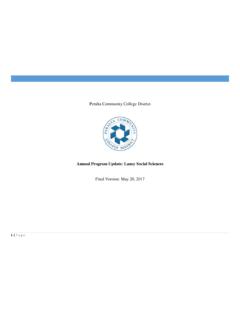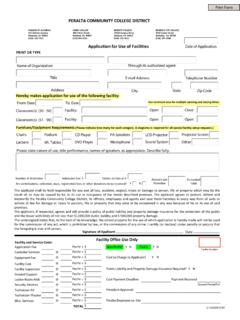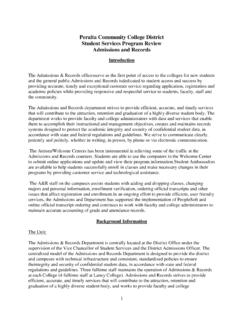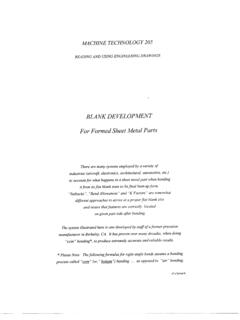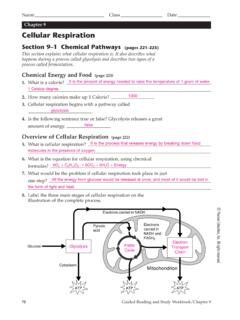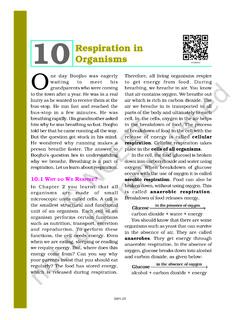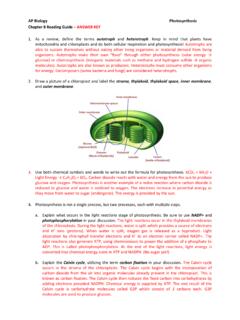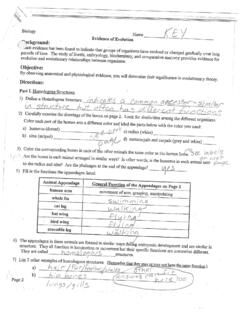Transcription of Human Physiology (Biology 4) Lecture Notes
1 1 Human Physiology (Biology 4) Lecture Notes Updated July 2017 Instructor: Rebecca Bailey 2 Chapter 1 Homeostasis Anatomy - the study of body structure Physiology - the study of body function 1. mechanistic approach a. explain how events occur b. , you shiver because a drop in body T leads to signals for muscle contraction 2. teleological approach a. explain how a function fills a need, "why" b. , you shiver because you need to keep warm 3. both approaches can be useful in understanding concepts Levels of Organization - Chemical level 1. atoms and molecules - Cells 1. the basic unit of living things 2. humans are multicellular 3. several basic functions of all cells a. obtain nutrients and O2 b. make usable energy, Food + O2 CO2 + H2O + energy c. eliminate wastes d.
2 Synthesize needed molecules e. respond to environmental changes f. control exchange of materials with the environment g. transport molecules h. reproduce 4. in multicellular organisms, cells specialize - Tissues 1. group of cells with similar structure and function a. plus extracellular material 3 2. 4 major types a. muscle (1) specialized for contraction and force generation (2) skeletal - movement of body or body parts (3) cardiac - pump blood (4) smooth - movement of organs b. epithelial (1) specialized for exchange between cell and environment (2) 2 general types - sheets and secretory glands (3) sheets are tightly joined cells covering or lining parts of the body (4) glands secrete products (exocrine glands have ducts leading to a body surface, sweat glands; endocrine glands release products to interstitial fluid and it goes into blood, adrenal glands) c.
3 Nervous (1) specialized for initiating and transmitting electrical impulses (2) brain, spinal cord, nerves d. connective (1) specialized for connecting and supporting (2) found all over body - Organs 1. group of two or more tissues designed to perform specific functions - Body System (organ system) 1. group of organs designed to perform particular functions - Whole Organism 1. group of organ systems Homeostasis - a dynamic equilibrium where body conditions are maintained within narrow limits 1. necessary for each cell to survive 2. each cell contributes 3. all cells are in contact with the aqueous (watery) internal environment, connects all cells, exchanges made a. outside cells, inside body 4 b. extracellular fluid (1) plasma (fluid in the blood) (2) interstitial fluid (surrounding cells) - Major factors maintained 1.
4 Concentration of nutrient molecules a. cells need energy and building blocks 2. concentration of O2 and CO2 a. O2 used to make usable energy (ATP) b. CO2 made must be removed 3. concentration of waste products a. become toxic at high levels 4. pH a. acidity affects enzyme reactions and nerve cell impulses 5. concentration of water, salt and other electrolytes a. maintaining cell volume b. various functions of electrolytes 6. temperature a. too cold or too much heat harmful to cells 7. volume and pressure a. blood must be at appropriate volume and pressure to be transported around the body 11 Major Organ Systems Control Mechanisms - body controlled mainly by nervous and endocrine systems - parts of a control system (all interdependent) 1. sensor a. monitors variable (factor being regulated) b.
5 Responds to changes (stimuli) by sending input 2. integrator a. determines set point (appropriate level of variable) b. compares set point to input c. sends response 3. effector a. responds to changes 5 - most control systems operate using negative feedback 1. decreases or shuts off original stimulus 2. resists change - positive feedback 1. enhances original stimulus 2. uterine contractions during childbirth 3. blood clotting 6 Chapter 2 Cell Physiology Cell basics - typical Human cell 10-20 m in diameter ( m = micrometer, 1/1000 mm, 1/1,000,000 m) - most cells have 3 major subdivisions 1. plasma membrane (cell membrane) a. defines inside/outside b. intracellular fluid (ICF) - inside cell c. extracellular fluid (ECF) - outside cell d. selectively permeable - controls movement of molecules between ICF and ECF 2.
6 Nucleus a. usually near cell center b. double layered membrane c. contains DNA, "genetic blueprint," directs protein synthesis, control center of cell 3. cytoplasm a. area between nucleus and plasma membrane b. contains organelles (1) separation of chemical reactions (2) specialized for a particular function c. cytosol is semiliquid, site of chemical reactions Organelles (see table Summary of Cytoplasm Components) - endoplasmic reticulum (ER) 1. interconnected fluid-filled membranous system 2. two types a. smooth - interconnected tubules b. rough - interconnected flattened sacs (1) has ribosomes which help in protein synthesis (cell also has "free" ribosomes) 3. rough ER a. synthesizes proteins and lipids, releases them to ER lumen (1) some will be secreted from the cell (hormones, enzymes), some will become new membrane for the cell or its organelles, or other protein parts of organelles (2) once in the lumen the protein can be modified (pieces removed, sugars added) 7 4.
7 Smooth ER a. in most cells it packages and transports products of rough ER (sections pinch off and become transport vesicles, move to Golgi complex) b. some cells have extensive specialized smooth ER (1) lipid synthesis (steroid hormone secreting cells) (2) detoxify harmful substances (liver cells) (3) store calcium (muscle cells) - Golgi complex 1. layers of flattened membranous sacs (cisternae) 2. processes ER products into final form 3. sorts and sends products to appropriate place a. transport vesicles take products to locations in or outside cell, coating made up of proteins that recognize the product and its destination b. secretory vesicles transport products out of specialized cells, fuses with plasma membrane (secretion, exocytosis) - lysosomes 1. membranous sacs containing hydrolytic enzymes 2. digest cellular debris and other substances (old organelles, bacteria) a.
8 Material from outside cell can be brought in to be digested by lysosome - endocytosis (membrane surrounds substance and vesicle pinches off) (1) pinocytosis - fluids, "cell drinking" (2) phagocytosis - large particles, "cell eating" b. cell can use digested material - peroxisomes 1. membranous sacs containing oxidative enzymes a. use oxygen to remove hydrogen from molecules (detoxify wastes and other chemicals like alcohol) - mitochondria 1. have double membrane a. inner membrane has folds called cristae (folds increase surface area) b. matrix is gel inside 2. play a role in apoptosis (programmed cell death) 8 3. converts energy from food into usable energy for the cell - ATP (adenosine triphosphate) a. energy in chemical bonds of food molecules can't be used directly b. ATP ADP +Pi + useful energy 4.
9 Three major steps in forming ATP (called cellular respiration ) a. glycolysis (1) in cytosol (2) glucose 2 pyruvic acid (a series of steps) (3) yields 2 ATP/glucose (not very efficient by itself) (4) attach H to carrier molecules b. citric acid cycle (also called Krebs cycle or tricarboxylic acid cycle) (1) pyruvic acid is transported to mitochondrial matrix (2) pyruvic acid acetyl CoA (3) acetyl CoA enters citric acid cycle, which is a series of reactions (4) CO2 is produced (5) hydrogen atoms are attached to carrier molecules (NAD+, nicotinamide adenine dinucleotide; FAD, flavine adenine dinucleotide; become NADH and FADH2) (6) 2 more ATP/original glucose c. electron transport chain/oxidative phosphorylation (1) occurs on inner mitochondrial membrane which contains electron carrier molecules (each H contains one electron, moving electrons means moving energy) (2) NADH and FADH2 from glycolysis and citric acid cycle enter chain, the electron is removed from each H and passed through the series of electron carriers in the membrane, finally ending up on O2 (the final electron acceptor) (3) the energy from the electrons is used to transport H+ (lost its electron) across the inner membrane.
10 This creates a concentration gradient - more H+ on one side of the membrane than the other - so H+ will flow back across the inner membrane (4) H+ can only flow back across at certain points - it flows through channels that contain ATP synthase (the enzyme that makes ATP) which is activated by H+ flowing by (5) yields 28 ATP/original glucose (6) steps 3 and 4 are known as the chemiosmotic mechanism (chemical reaction coupled to flow of a substance across a membrane) (7) because O2 is used to make ATP, it is called oxidative phosphorylation 9 (glycolysis can happen anaerobically - w/o O2 - but this alone is not very efficient) (8) H2O is formed from O2 and H+ (9) passing electrons in steps means energy is released slowly (releasing it all at once would create so much heat it would kill the cell) 5. not all the energy in glucose is used to make ATP (no energy transfer is 100% efficient) 6.


